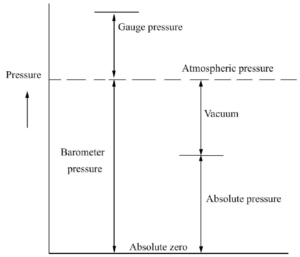Absolute – Barometric to Gauge Pressure
PRESS ENTER ON KEYBOARD TO CALCULATE OR CONVERT
Definition Absolute Pressure
The absolute pressure – pa – is measured relative to the absolute zero pressure – the pressure that would occur at absolute vacuum. All calculation involving the gas laws requires pressure (and temperature) to be in absolute units. Absolute pressure is determined as algebraic sum of the readings of a barometer and of a manometer showing the gauge pressure. Manometers which measure absolute pressure are also available. They measure the pressure with reference to absolute zero pressure.
Definition Gauge Pressure
A gauge is often used to measure the pressure difference between a system and the surrounding atmosphere. This pressure is often called the gauge pressure.Therefore Gauge pressure is measured from atmospheric and absolute is measured from 0 (as all absolute scales are measured from). They both use the same scale for measuring.
Standard atmosphere at sea level is 14.7lb/in^2 of pressure absolute and 0 pressure gauge. If you had 100 psi gauge pressure you’d have 14.7+100psi absolute. Atmospheric Pressure
Atmospheric pressure is pressure in the surrounding air at – or “close” to – the surface of the earth. The atmospheric pressure varies with temperature and altitude above sea level.
Description of the pressure terminology

Common Units
1Pascal(1N/m²) = 10dyne/cm²
1mmHg = 133.32pascals
= 13.595mm Water
Standard atmosphere = 1.013 * 105N/m²
1 millibar = 1000 dyn/cm²
1 micron = 10-6mHg
1 torr = 1 mmHg
= 1000micron
The symbol for pressure is lowercase p, and the unit of pressure is the pascal (Pa), which is 1 N/m2. The pressure at sea level on Earth is around 105 Pa, varying with position and time; its mean value, around 101,3±0,2 kPa, was established exactly as 1.01325∙105 Pa by international agreement, based on the pressure of a 760 mm high mercury column at 0 ºC and g=9.80665 m/s2, what was named one standard atmosphere (1 atm≡101.325 kPa). Typical weather change causes some 1 kPa pressure variations (up to 5 kPa in hurricanes). There is a trend to use 105 Pa as the standard value of pressure (IUPAC changed in 1982 from 1 atm to 105 Pa); although the substitution of 1 atm by 1 bar is insignificant in most engineering problems, notice that their difference is the typical pressure variation due to weather changes at a site, and that 1 bar=750 mmHg (whereas 1 atm≡760 mmHg; the old pressure units of one millimetre of mercury column, 1 mmHg, 1 torr≡1 mmHg, one metre of water column, one kilopond per square centimetre, and so on, are totally outdated). The bar (1 bar≡105 Pa) is a non-SI units currently accepted for use with the International System, but whose use is discouraged (as well as its submultiples, as the millibar, 1 mbar=100 Pa). By the way, there is some tendency to directly substitute 1 mbar=1 hPa, but the prefix hecto is also discouraged
Relation between absolute and gauge pressure
The absolute pressure Pabs is calculated from the gauge pressure at port P and the atmospheric pressure Patm
Gauge Pressure: Pg = Pa – Pat
Atmospheric Pressure: Pat = Pa – Pg
where, Pa = Absolute Pressure, Pg = Gauge Pressure, Pat = Atmospheric (Barometric) Pressure.
How to use: Insert the value (absolute or Gauge) to be converted or calculated into the input box, then click outside the input boxes or pressure enter on your keypad to calculate and the results shall be displayed for various units as required. You can click on reset icon to clear the data and restart new conversion.
This calculator will calculate the gauge pressure by subtracting the barometric pressure from the absolute referenced pressure reading you entered and convert any combination of pressure units for each pressure value.
Please send us feedback or an email if you have suggestions on how to improve this site for your use or if you would like to see more conversions calculator included.

